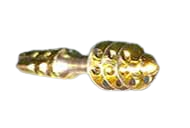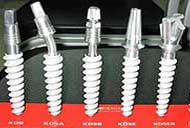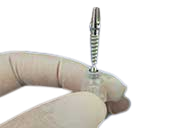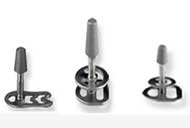Your medical advisor
Xavier Bourquin

Contact me on WhatsApp
[ht-ctc-chat]


The basal implant has been known and practiced for many years, its name comes from the part of the bone in which it is implanted, the basal part, also called cortical bone. Indeed, it is the most mineralized part of the bone, the hardest. On the contrary, the traditional implant is implanted in the spongy part of the bone which requires osseointegration. This therefore leads to a longer processing time. There are 2 types of basal implant. Disc implants (BOI implant) which are the first generation of basal implants, and the latest generation basal implant BAx. It is obvious that our dental clinics mainly work with the latest generation basal implant.
Immediate implantation with basal implants is a convenient, fast and safe method. Patients have less post-operative pain, complications, care and less cost. In addition, the patient leaves directly with fixed teeth relative to conventional dental implants.
1. The basal implant can be fixed in any hard bone anywhere, regardless of its volume. In addition, the teeth can be fixed directly after the insertion of the implant without waiting for a period of osseointegration (regeneration of the bone), and without bone grafting or sinus lift. Indeed, basal implants give possibilities to patients who have a bone problem or a problem of retraction of the gums.
Basal implants with immediate fixation give great hope of success. Moreover, the new design of the basal implants in one piece and their smooth surface make them practically indestructible and avoid inflammation (peri-implantitis). Thus, basal implants can be placed safely in patients who smoke or in patients with periodontal disease.
2. Above all, the problems encountered in conventional two-piece implants are:
– a rough surface (strong bacterial colonization)
– the unstable relationship between the implant and the dental superstructure
– expecting a long period of bone healing after tooth extraction
– the period of osseointegration
Obviously, this gives a great advantage to basal implants.
For treatment with placement and immediate loading (strategic implantation) each implant must be anchored in at least two places in the hard (cortical) bone. This bone has a high level of mineralization (very hard), stability and low metabolism and can be placed instantly.
3. When we apply the strategic implantation technique with immediate loading, we practically reduce the treatment time from 4-5 months to only 5 days. Also, we minimize the risks to patients of additional surgical manipulations such as bone augmentation and sinus lift. This minimizes the pain caused by these operations as well as the unnecessary costs of them.
There is no risk of loosening the screw tensions as the implant is in one piece. Indeed, any problem related to the connections between the implant and the superstructure on the implant is avoided (crown problem, peri-implantitis).
Basal implants can be placed on diabetic patients, smokers, patients suffering from osteoporosis or even patients with chronic periodontitis (periodontitis).
With basal implantation, no additional bone grafting is needed to increase bone volume (as in conventional implants, where bone grafting is needed in the maxillary sinus).
This is due to the variety of shapes, sizes and specific design of basal implants.
Basal implants have a smooth, polished surface that prevents bacterial colonization on the surfaces of the implants, which in turn eliminates the occurrence of peri-implantitis.
A single surgical intervention with minimal intervention by local anesthesia is necessary to place the basal implants.
The implantation of basal implants can be performed simultaneously with the extractions of all diseased teeth (deep fractures, very mobile periodontal teeth, teeth with chronic periodontitis), the sculpture of the alveolar ridge and gingival plasticity.
Anchored basal implants distribute the biomechanical loads of chewing forces to the areas around the bone which are compact, highly resorbable and have the highest weight.
Basal implants can be placed even in the most unfavorable bone situations, regardless of the degree of bone loss: In the lower jaw – in case of severe bone deficiency, to avoid the lower mandibular nerve, they are placed biocortically (in the vestibule-lingual direction). In the upper jaw, long basal implants bypass the sinuses holding the bones anterior and posterior to the maxillary sinus (tuberopteroid implants), eliminating the need for bone augmentation and sinus lifting.
1. In the case of extractions of several teeth and roots and the simultaneous insertion of basal implants, a natural retraction of the gums and a subsequent fusion of the bone are obtained. This can lead to a space between the gum and the tooth that is not aesthetically optimal. In such cases, we prefer to place fixed temporary constructions for a period of 8 months – 1 year minimum, and then replace them with permanent ceramic constructions.
Note: Therefore, it is necessary, at the same time as the implantation, after the tooth extraction, to also make a plasticization of the gums as well as a release of the wavy alveolar ridge. This aims to radically eliminate all inflammatory and necrotic areas and prepare the healing for the fixation of the teeth. Thus, the retraction of the gums is reduced to a minimum. In addition, there is a uniform dental construction load.
2. With patients who use oral or intravenous bisphosphonates (especially those with nitrogenous side chains) for a long time (4-5 years) in the treatment of osteoporosis.
Note: bisphosphonates with nitrogen side chains inhibit bone resorption (which occurs in osteoporosis). In this way, bone metabolism slows down, which prevents implant treatment and all healing processes in the jawbone. If jawbone implantation is necessary, patients should discontinue use of these medications if possible after consulting a specialist. After stopping these drugs, it is possible to apply the treatment with basal implants.
Basal implant systems are made of fracture-resistant Ti6Al4V titanium alloys.
Simpladent GmbH (Ihde dental/Biomed) manufactures a variety of types of basal implants for immediate loading to treat all tooth problems. They are certified (patented) and therefore of guaranteed quality.

Indeed, after the extraction of the teeth, the BCS implant is directly placed in the place of extraction. Their special design is a combination of wide incisions specially designed for self-drilling. Thus, this ensures maximum stability avoiding unfavorable lateral forces.

They are placed in the cancellous bone and compressed (pressed) laterally.
They are placed without an incision in the crown, through the gumline and transfer pressure only to the cortical bone.

The unique design combines the technology of compression implants and cortical implants for areas with uneven bone density. Implant combined with three different thread designs of an implant. The micro-thread in the first cortex provides stability, the cut line in the middle allows secure fixation in new extractions, and the apical compression thread provides stability. Major primary stability is achieved.

These are disc implants. They are placed in the cortical part, laterally, in a strongly atrophied jaw bone.
Perfect distribution of chewing forces.
Xavier Bourquin

Contact me on WhatsApp